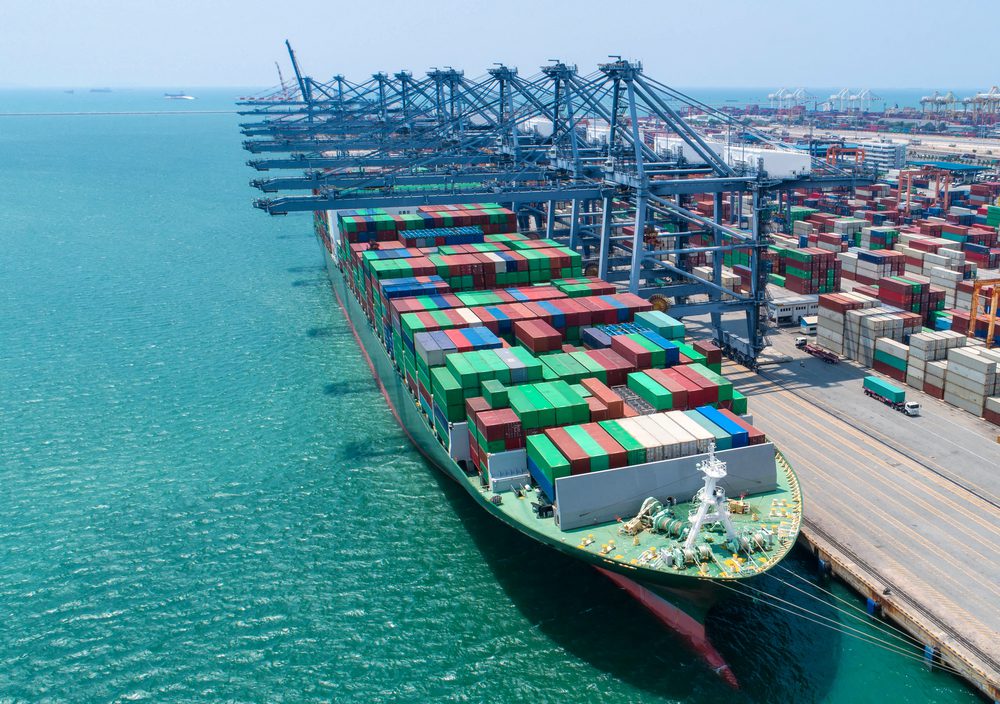Photo: MAGNIFIER / Shutterstock
By Mike Wackett (The Loadstar) – Scrubbers installed on ultra-large large container vessels (ULCVs) could take up “at least 200 teu” of container slots, according to Alphaliner.
The consultant estimated this loss on Evergreen’s G-Class 20,150 teu newbuild, the Ever Govern, under construction at in Japan, compared with an already delivered sister vessel.
Alphaliner said it appeared that the scrubber housing on the newbuild would be six or seven containers wide and occupy a 40ft container bay.
“Quite a notable negative effect upon the ship’s container capacity,” it said.
This permanent sacrifice of revenue will be another factor ocean carriers will need to take into consideration when deciding on their strategy to comply with IMO 2020.
An unknown factor in the calculation is the actual difference in price between the current heavy fuel oil (HFO) mainly consumed by the world’s maritime fleet, and the maximum 0.5% sulphur content LSFO (low-sulphur fuel oil) allowable by the IMO from 1 January next year.
Although the bunker industry does not expect to publish forward pricing for LSFO until the third quarter this year, the expectation is that the ‘spread’ will be in the region of $200 per tonne.
Given that a ULCV will burn around 200 tons a day while at sea, on that basis the price of retrofitting a scrubber to existing fleet, along with the six-week cost of taking the vessel out of service, could be recovered in less than two years.
However, at the TPM Conference in Long Beach last week there was a considerable divergence of opinion by analysts of what the increase in price of LSFO will be compared to HFO, with some suggesting that the gap might be as low as $50 per tonne.
One speaker argued that as the majority of demand post IMO 2020 will be for LSFO – only around 5% of the global container fleet is expected to have scrubbers fitted by the start of the regulations – the price of the compliant fuel would naturally fall over time, and that in contrast the niche requirement for HFO could actually make it more expensive.
What was of more concern to carriers that The Loadstar spoke to at TPM was whether the bunker industry could meet the immediate demand for the switch to LSFO in the months before the 1 January 2020 start date.
Indeed, there was much talk of an “IMO scramble” at the conference.
“We will have to start bunkering our ships with LSFO sometime in Q4,” said one operations director of a carrier, “but before we bunker with the low-sulphur fuel we will have to spend some time in port cleaning the tanks and pipes or the new fuel will be contaminated,” he warned.
Meanwhile, other than for newbuild ULCVs the LNG retrofit option seems to be a non-starter – even before the bunkering restrictions are factored in.
At a breakfast briefing during TPM, Hapag-Lloyd’s chief executive, Rolf Habben Jansen told The Loadstar that a “ballpark figure” for the trial retro-fitting of one of its ‘LNG-ready’ 15,000 teu vessels, inherited from its merger with UASC, was $25m.
According to vesselsvalue.com the current value of the four-year-old 14,993 teu Sajir, the ex-UASC ship which Hapag-Lloyd is fitting out with LNG tanks, is $80m.
The Loadstar is fast becoming known at the highest levels of logistics and supply chain management as one of the best sources of influential analysis and commentary.
Check them out at TheLoadstar.co.uk, or find them on Facebook and Twitter.
Unlock Exclusive Insights Today!
Join the gCaptain Club for curated content, insider opinions, and vibrant community discussions.

 Join The Club
Join The Club







![A screengrab of a map showing an earthquake Mindanao, Philippines on Dec 2, 2023. (Image: US Geological Survey [USGS])](https://gcaptain.com/wp-content/uploads/2023/12/Screenshot-2023-12-02-at-10.45.17-AM-copy.png.webp)





